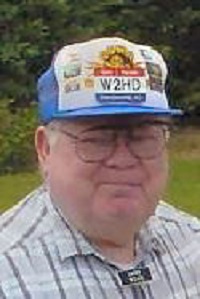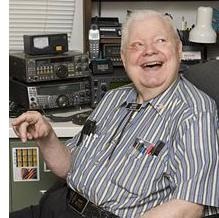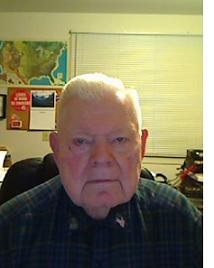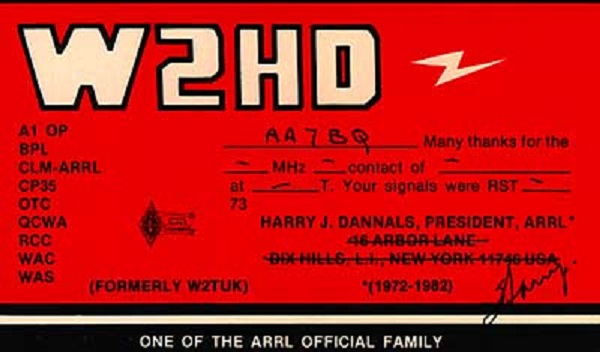|
Fellow - Radio Club of America ARRL President 1972-1982 ARRL President Emeritus ARRL VE - Volunteer Examiner CARF - Honorary Associate Member CQ Hall of Fame - 2002 OOTC - Old Old Timers Club SOWP - Society of Wireless Pioneers VWOA - Veteran Wireless Operators Association A-1 Operators Club Brass Pounders League Rag Chewers Club Worked All States Worked All Continents |
 Field Day 2004 |
W2HD Harry J. Dannals Charlottesville, VA QCWA # 7425 Chapter 155 President Emeritus Announcement Presented 6/16/2010 by Vic, W4VIC |
Monitoring Times Nov 2009 index W2HD article
Charlottesville Daily Progress - Special to The Daily Progress/Jason O. Watson
By David A. Maurer - Published: July 28, 2008
Ham radio ambassador: Nothing amateur about this form of communication
Harry J. Dannals, a longtime member of the Albemarle Amateur Radio Club, says there's nothing amateur about his craft. "Not true," he says. "It only means we're not being compensated financially for what we're doing."
For most of his 81 years Harry J. Dannals has used the dots and dashes of Morse code to meet and say howdy to people around the world.
The enthusiastic ambassador for amateur radio has also used his voice to communicate with other devotees who delight in fine tuning radio dials and antennas. As the president of the American Radio Relay League from 1972 to 1982, he traveled to all 50 states, as well as Puerto Rico, the Canal Zone, Canada and Mexico, to meet and talk with people who share an interest in his hobby.
The longtime member of the Albemarle Amateur Radio Club also has the distinction of being the only person to have been president of the ARRL and the Quarter Century Wireless Association. As he relaxed in the "radio shack" room in his home just north of Charlottesville, he reflected on his many years as a ham; an informal term for an amateur radio operator.
"The only thing I think is wrong about all this is the word amateur," Dannals said after turning down the volume of a Morse code transmission. "That makes us sound like raw beginners."
"Not true. It only means we're not being compensated financially for what we're doing. Some radio amateurs are among the most professional and capable people I know.
"This hobby has given me a tremendous feeling of personal satisfaction, and the ability to talk to people, and know people, from all walks of life, whether they be around the corner or on the other side of the world. We become friends and that's what it's all about."
What the hobby can also be all about during times of emergency is serving as a lifeline of sorts. Whether the crisis arrives as a natural disaster or terrorist attack, amateur radio operators can serve as vital communication links between isolated areas and the outside world.
Dave Damon, current president of the AARC, is dedicated to providing that service when needed.
 "Our club per se doesn't deal with emergency communications," Damon explained. "That's handled by ARES, which stands for Amateur Radio Emergency Service. It's part of the field organization for ARRL."
"Our club per se doesn't deal with emergency communications," Damon explained. "That's handled by ARES, which stands for Amateur Radio Emergency Service. It's part of the field organization for ARRL."
"In a lot of emergencies normal communication pathways are somewhat intact. But there are the occasional emergencies like Hurricane Katrina when landlines and cell phones are gone, and there's no way for people to communicate."
"That happened in Virginia in 1995 when the Blackwater River flooded and Franklin was cut off. There was no phone service in the town, and the only communications in and out was supplied by amateur radio operators."
Prepared for the worst
Since 9/11 members of ARES have increased their training and readiness level. On many weekends they can be found in the field practicing their skills by supporting local activities.
"So far this year we've provided communications for a number of events such as the Jefferson Cup Bike Races and the MS 150 Bike Tour," said Damon, who is a member of ARES and an emergency coordinator for ARRL.
"Because we're beginning to expect ARES members to be better trained, I think we are accepting the fact that we are going to lose some of the less committed people. So we're looking at having to do more with fewer but better trained people."
As Dannals proudly pointed out, it's all but impossible to keep a dedicated ham off the air. Some years ago he participated in a mock-terrorist attack at the Charlottesville-Albemarle Airport.
The exercise's scenario called for the complete disruption of 911 emergency communications. Dannals and other local ham operators quickly established and maintained communication links, and began relaying messages to hospitals, police, firefighters and other emergency services.
The effort received high praise, and proved that even in an era of cell phones and instant messaging, amateur radio operators are as important as ever.
"Amateur radio operators are a very innovative group," Dannals said as a smile spread across his face. "If you try to take us off our radio, we'll find some way to get back on the air."
"I have an emergency generator, and if I have to I can switch over to a battery. Just recently the Chinese government issued a public citation to thank all the amateur radio operators in China and elsewhere who helped them after the terrible earthquake there."
Storm watcher
Jeffrey Seay, 19, has been a member of AARC since he received his license from the Federal Communications Commission on Dec. 26, 2001. One of his interests is heading up the local Skywarn program, which was established in the 1970s by the National Weather Service.
The program enlists ordinary citizens such as amateur radio operators to spot, identify and describe severe local storms.
"I've always enjoyed the weather, so this is something where I can combine my interest in radio with a useful service to the community," said Seay, who also serves as the club's public information coordinator.
"I've had meteorologists tell me that they listen to us for information. This program is an example of the many avenues one can go down with amateur radio.
"The possibilities are nearly endless. The focus can go from building your own radios to participating in public service."
 Currently there are 88 members of the AARC. Damon said he'd be hard pressed to find two members with the exact same interest. The reasons why they've gotten involved in the hobby are equally as diverse as their interests.
Currently there are 88 members of the AARC. Damon said he'd be hard pressed to find two members with the exact same interest. The reasons why they've gotten involved in the hobby are equally as diverse as their interests.
"I got interested through using citizen band radio, like truckers use," said Damon, who worked in a medical research laboratory at the University of Virginia for nearly 32 years before retiring.
"When I looked into amateur radio I discovered that CB radio was this little part of it, and amateur radio was wall to wall."
Anybody can buy a radio and listen in, but if one wants to transmit a message on the airways a license issued by the FCC is necessary. When Dannals took and passed his licensing test in 1946 the exam was much more difficult than it is today.
"When I took the exam you had to write the answers to the questions out in longhand," said Dannals, who credits his early interest in radios for leading him into a career as an electrical engineer. And you had to draw the schematic diagrams they asked for.
Now the questions are multiple choice. And just a couple years ago they did away with the Morse code requirement, which was a stumbling block for some people.
As soon as that requirement was dropped, the rolls of amateur radio members increased somewhat. However, there's still a lot of interest in Morse code.
When I was 10, my best friend and I learned Morse code together. We practiced with something called a postal telegraph set that had the code printed on the front of it, and came with a buzzer, sounder, light and a key device to send messages.
We would wire it from one room to the next and send each other messages. I eventually got to where I could send and receive 50 to 60 words a minute."
Dannals said he has slowed to about 40 to 45 words a minute, but anyone familiar with the code knows that's still dazzlingly fast. During the last few decades the change in radio technology has been fast as well.
"The big change in the equipment is that it's now all solid state with no tubes," Damon said. "In the old days a radio operator would have a rank covering an entire wall filled with equipment."
"Now that same capability can be found in a single unit. I think it's such an incredibly neat concept that when I depress the push-to-talk button I have a radio signal that goes out and keeps on going."
"And it takes very little power to do it. I can communicate around the world with a power output about equal to a light bulb. I've talked to Perth, Australia, which is about as far as you can go before coming back."
Affordable hobby
Damon said a person can get into the hobby for as little as $14, which is the cost of taking the required test to be licensed. AARC recently received a contribution in memory of longtime club member Steve Clements from his family. The money was used to update amateur radio study material at the Jefferson-Madison Regional Library.
After sending and receiving messages around the world for more than seven decades, Dannals knows just how special his hobby is.
"When we go on the air we don't know race, creed, religion or anything about the person we're communicating with," said Dannals, who is known far and wide by his call sign W2HD. "We only know what they tell us by voice or with dots and dashes."
"The common bond we share is our interest in amateur radio, and that helps us become instant friends. My father was a ham and he got me into the hobby."
"I would listen to him talk with people overseas, and one of his best radio friends was named Bill Nightingale in Birmingham, England. They would talk almost every day, so I got to know Bill like he was an uncle."
"I remember thinking, 'Gee, this is wonderful.' I just marveled at what amateur radio could do."
Those interested in learning more about the hobby or the Albemarle Amateur Radio Club can visit www. albemarleradio.org.
NEWSLINE RADIO - CBBS EDITION #1141 - 06/25/99
http://www.arnewsline.org/newsline_archives/cbbs1141.txt
Harry Dannals, W2HD retiring from ham radio convention circuit
A name synonymous with Amateur Radio for the better part of five decades has announced that he is stepping out of the ham radio spotlight. This as former ARRL President Harry Dannals, W2HD, makes known his plans to devote more of his time to family and just having fun on the air.
Dannals, who turned 72 in April, made the announcement at the recent Rochester Hamfest banquet. This is an event which he has presided over for the past twenty plus years. Newsline caught up with W2HD after the show and asked why he picked 1999 to say good-bye to the convention circuit:
"I'm not going to retire. I couldn't. Ham Radio has been a big part of my life. I'm a son of a ham. The father of two. The brother of two. and friends with so many others. I could never really quite.
It's just the travel from here to where ever I have to go." Harry Dannals, W2HD
Dannals grew up and spent most of his life on Long Island, New York. Several years ago he retired to the Charlottesville, Virginia area. He says that the place is great, but its not all that easy to travel in and out of. Hence, part of the reason for his decision to spend more time at home:
"Charlottesville is a little place. I've got to take a commuter/grasshopper airline to get any place out of here. And then there is another wait. And the same old problem to get home from Rochester. And it just gets to you after a while."
"The biggest thing that I will miss, without any exception is the opportunity to meet so many of my old friends the second, third, fourth, fifth, tenth times, whatever it would be. That will be the real problem for me."
What about the future:"Well I have so many little things that I play with in ham radio. I'm involved a little bit with the APRS Program that they have here in town, and I enjoy it. I enjoy the facets of Amateur Radio that have come into being with the changes that we've had. I think that technology keeps on drawing me closer to further interests."
Dannals W2HD did tell Newsline that he may make one final appearance. This, at next years combined Dayton Hamvention and ARRL National Convention. Meantime we at Newsline join with the rest of Amateur Radio in saying -- well done W2HD.
More from: NEWSLINE RADIO - 01/29/10 - NAMES IN THE NEWS:HARRY DANNALS, W2HD, NAMED PRESIDENT EMERITUS OF THE QCWA
A name synonymous with ham radio for over seven decades has become only the third person ever elevated to the post of President Emeritus of the Quarter Century Wireless Association. This as the organization names Harry Dannals, W2HD, of Charlottesville, Virginia to this truly prestigious standing.
Perhaps best known for his decade from 1972 to 1982 as president of the American Radio Relay League, Harry also served as President of the QCWA from 1989 to 1994. As such he is the only person to have ever held this leadership position in both organizations.
In addition to his work with both the QCWA and ARRL where he also holds the status of President Emeritus, the former W2TUK is a Fellow in the Radio Club of America, a member of the Society of Wireless Pioneers, the Old Old Timers Club, and the Veteran Wireless Operators Association. In 2002 he was inducted into the CQ Magazine Amateur Radio Hall of Fame.
Harry Dannals elevation as President Emeritus of the Quarter Century Wireless Association was announced on January 22nd. The only others ever elected to this position within the QCWA were Leland W. Smith, W5KL, and Lewis 'Mac' McCoy, W1ICP, both of whom are now Silent Keys.
The Canadian Amateur, October 1973, page 6 reports: at the Annual Convention of the Radio Society of Ontario that: Noel Eaton, VE3CJ and Harry Dannals, W2TUK (later W2HD) were honored as "Honorary Associate Members" of CARF. Certificates presented by A. Blick.

December 13, 2018